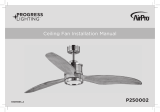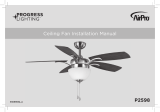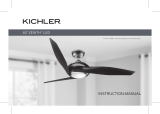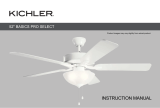La page est en cours de chargement...

Ceiling Fan Installation Manual
P25006 3
93133628_A

Date Purchased
Store Purch as ed
Model No .
Serial No.
Vend or No.
UPC
126900
785247249404
785247249398
Limited Lifetime Warranty
Progress Lighting fan motors are warranted to the original purchaser to be free of electrical and/or mechanical defects for so
long as the original purchaser owns the fan. Pull chain switches, reverse switches, capacitors and metal finishes are warranted to
be free from defects in materials or workmanship for a period of 1 year from the date of purchase. Warping of wooden or plastic
blades is not covered by this warranty nor is corrosion and/or deterioration of any finishes for fans installed within ten miles of
any sea coast. Extended warranties for ENERGY STAR
®
qualified products may apply.
Progress Lighting ceiling fans with built-in LED light sources, when properly installed and under normal conditions of use, are
warranted to be free from defects in material and workmanship which cause the light sources to fail to operate in accordance
with the specifications for (i) five (5) years from the date of purchase on the LED Light modules and electrical components for
fans used in single family residences, and (ii) three (3) years from the date of purchase on the LED Light modules and electrical
components for fans used in multi-family or commercial applications. LED bulbs supplied by Progress Lighting carry no
warranty other than manufacturer’s warranty. Non-LED bulbs carry no warranty.
With proof of
purchase, the original purchaser may return the defective fan to the place of purchase during the first 30 days for
replacement. After 30 days, the original purchaser MUST contact Progress Lighting at (864) 678-1000 for repair or replacement
which shall be determined in Progress Lighting’s sole discretion and shall be purchaser’s sole and exclusive remedy.
Labor and Shipping Excluded. This warranty does not cover any costs or fees associated with the labor (including, but not
limited to, electrician’s fees) required to install, remove, or replace a fan or any fan parts.
This warranty shall not apply to any loss or damage resulting from (i) normal wear and tear or alteration, misuse, abuse or
neglect, or (ii) improper installation, operation, repair or maintenance by original purchaser or a third party, including without
limitation improper voltage supply or power surge, use of improper parts or accessories, unauthorized repair (made or
attempted) or failure to provide maintenance to the fan.
THE FOREGOING WARRANTIES STATE PROGRESS LIGHTING’S ENTIRE WARRANTY OBLIGATION AND
ORIGINAL PURCHASER’S SOLE AND EXCLUSIVE REMEDY RELATED TO SUCH PRODUCTS. PROGRESS
LIGHTING IS NOT RESPONSIBLE FOR DAMAGES (INCLUDING INDIRECT, SPECIAL, INCIDENTIAL OR
CONSEQUENTIAL), DUE TO PRODUCT FAILURE, WHETHER ARISING OUT OF BREACH OF WARRANTY,
BREACH OF CONTRACT, OR OTHE
RWISE. THIS WARRANTY IS GIVEN IN LIEU OF ALL OTHER WARRANTIES,
WHETHER EXPRESSED OR IMPLIED, INCLUDING THOSE OF MERCHANTABILITY, FITNESS FOR A PARTICULAR
PURPOSE OR NONINFRINGEMENT.
Some states do not allow limitations on how long an implied warranty lasts or the exclusion or limitations of incidental or
consequential damages, so the above limitations and exclusions may not apply to you. This warranty gives you specific rights
and you may have other rights which vary from state to state.

Table of Contents
Safety Rules.....................................................................................................................................................................................
Unpacking Your Fan .......................................................................................................................................................................
Installing Your Fan .........................................................................................................................................................................
Installing the Decorative Cover ......................................................................................................................................................
Operating Your Transmitter ............................................................................................................................................................
Care of Your Fan ...........................................................................................................................................................................
Wifi Control Setup - Smart Device Control .................................................................................................................................
Wifi Control Setup - Smart Speaker Voice Control ....................................................................................................................
1.
2.
3.
8.
9.
10.
11.
12.
Troubleshooting ............................................................................................................................................................................
Specifications ................................................................................................................................................................................
13.
14.

1. Safety Rules
To reduce the risk of electric shock, ensure electricity has been turned off
at the circuit breaker or fuse box before beginning.
1.
All wiring must be in accordance with the National Electrical Code
“ANSI/NFPA 70-1999” and local electrical codes. Electrical installation
should be performed by a qualified licensed electrician.
2.
The outlet box and support structure must be securely mounted and
capable of reliably supporting a minimum of 35 lbs (15.9 kg) or less. Use
only UL-listed outlet boxes marked “FOR FAN SUPPORT.”
3.
The fan must be mounted with a minimum of 7 ft. (2.1m) clearance from
the trailing edge of the blades to the floor.
4.
Avoid placing objects in the path of the blades.
5.
To avoid personal injury or damage to the fan and other items, be
cautious when working around or cleaning the fan.
6.
Do not use water or detergents when cleaning the fan or fan blades. A dry
dust cloth or lightly dampened cloth will be suitable for most cleaning.
7.
After making electrical connections, spliced conductors should be turned
upward and pushed carefully up into the outlet box. The wires should be
spread apart with the grounded conductor and the equipment-grounding
conductor on one side of the outlet box and ungrounded conductor on the
other side of the outlet box.
8.
All set screws must be checked and retightened where necessary before
installation.
9.
This device complies with Part 15 of the FCC Rules. Operation is subject
to the following two conditions:
(1) This device may not cause harmful interference, and (2) this device
must accept any interference received, including interference that may
cause undesired operation. Please note that changes or modifications not
expressly approved by the party responsible for compliance could void
the user's authority to operate the equipment.
Note:
This equipment has been tested and found to comply with the
limits for Class B digital device, pursuant to part 15 of the FCC Rules.
These limits are designed to provide reasonable protection against
harmful interference in a residential installation.This equipment
generates, uses and can radiate radio frequency energy and, if not
installed and used in accordance with the instructions, may cause harmful
interference to radio or television reception, which can be determined by
turning the equipment off and on, the user is encouraged to try to correct
the interference by one or more of the following measure.
- Reorient or relocate the receiving antenna.
- Increase the separation between the equipment and the receiver.
- Connect the equipment into an outlet on a circuit different from that to
which the receiver is connected. Consult the dealer or an experienced
radio/TV technician for help.
10.
WARNING
TO REDUCE THE RISK OF PERSONALL INJURY, DO NOT BEND THE BLADE ARMS (ALSO REFERRED TO AS
FLANGES), WHEN INSTALLING THE BRACKETS, BALANCING THE BLADES OR CLEANING THE FAN. DO
NOT INSERT FOREIGN OBJECTS IN – BETWEEN ROTATING FAN BLADES.
NOTE
READ AND SAVE THESE INSTRUCTIONS
WARNING
TO REDUCE THE RISK OF FIRE, ELECTRIC SHOCK, OR OTHER PERSONAL INJURY, MOUNT FAN ONLY ON AN
OUTLET BOX OR SUPPORTING SYSTEM MARKED ACCEPTABLE FOR FAN SUPPORT OF 35 LBS (15.9 KG) OR LESS
AND USE MOUNTING SCREWS PROVIDED WITH THE OUTLET BOX. MOST OUTLET BOXES COMMONLY USED FOR
THE SUPPORT OF LIGHTING FIXTURES ARE NOT ACCEPTABLE FOR FAN SUPPORT AND MAY NEED TO BE
REPLACED. CONSULT A QUALIFIED ELECTRICIAN IF IN DOUBT.

Unpack your fan and check the contents. You should have the following items:
Unpacking Your Fan 2.
9. Loose parts bag containing:
a. Blade attachment hardware
(13 screws)
b. Blade holder screws(4)
c. Cable hardware
(1 pcs per item)
1. Fan blades (3)
2. Ceiling bracket assembly
3. Motor assembly
4. Blade holder ring
5. Decorative cover
6. Receiver with 4 wire nuts
7. Transmitter incl. holder + 2 mounting screws
8. 3V battery
1
2
4
5
3
9
a
6
8
7
b
c
5
6
12
0
3
4
d
d. Mounting hardware
Wire nuts (4)

Tools Required
Phillips screw driver, straight slot screw driver,
adjustable wrench, step ladder, and wire cutters.
Mounting Options
If there isn't an existing UL listed mounting box,
then read the following instructions. Disconnect
the power by removing fuses or turning off
circuit breakers.
Secure the outlet box directly to the building
structure. Use appropriate fasteners and building
materials. The outlet box and its support must be
able to fully support the moving weight of the
fan (at least 35 lbs). Do not use plastic outlet
boxes.
Figure 1
Figure 2
Outlet box
Outlet box
3. Installing Your Fan
WARNING
TO REDUCE THE RISK OF FIRE, ELECTRIC
SHOCK, OR OTHER PERSONAL INJURY,
MOUNT FAN ONLY TO AN OUTLET BOX
MARKED ACCEPTABLE FOR FAN SUPPORT
AND USE THE MOUNTING SCREWS
PROVIDED WITH THE OUTLET BOX. OUTLET
BOXES COMMONLY USED FOR THE
SUPPORT OF LIGHTING FIXTURES MAY NOT
BE ACCEPTABLE FOR FAN SUPPORT AND
MAY NEED TO BE REPLACED. CONSULT A
QUALIFIED ELECTRICIAN IF IN DOUBT.

4.
Hanging the Fan
REMEMBER to turn off the power. Follow
the steps below to hang your fan properly:
Step 1. Check existing outlet box (not included)
to ensure it is securely fastened to at least two
points in a structural ceiling member and can
support the full weight of the fan.Once verified,
install ceiling bracket assembly to the outlet box
using the screws and washers provided with the
outlet box(Figure 3).
Step 2. Remove two diagonal mounting screws
Step 4. Drive a wood screw and washers into
the side of the brace that holds the outlet box.
Leave 3mm (1/8”) of space between the support
brace and the washer. Insert the safety cable
through the Ceiling bracket assembly and one of
the holes in the outlet box into the ceiling. Adjust
the length of the safety cable to reach the screw
and washers by pulling the extra cable through the
cable clamp until the overall length is correct, put
the end of the cable back through the cable clamp,
forming a loop at the end of the cable. Tighten the
cable clamp securely. Now, put the loop in the
end of the safety cable over the wood screw and
under the washer. Tighten the wood screw
securely.(Figure 5)
on the round holes, keep for later use. And loosen
the other two screws (Figure 4).
Step 3. Hang the motor assembly onto the hook
from the ceiling bracket assembly. This will
allow for hands-free wiring (Figure 5).
DANGER: A loose outlet box can cause the
fan to wobble and increase the fan’s potential to
fall, which could result in serious injury or death.
Figure 3
Figure 4
Mounting screws
(supplied with
electrical box)
UL Listed
Ceiling
bracket
assembly
electrical
box
120V Wires
Washers
Motor
assembly
Ceiling bracket
assembly
Motor assembly
Safety cable
Spring
washer
Wood screw
Washer
Figure 5

5.
Figure 6
Figure 7
Ceiling
bracket
assembly
Motor assembly
Receiver
Making the Electrical
Connections
If you feel you do not have enough electrical
wiring knowledge or experience, have your fan
installed by a licensed electrician.
1.
2.
3.
(Figure 6) Insert the receiver into the
Ceiling bracket assembly with the flat side
of the receiver facing the ceiling.
(Figure 7) Motor to receiver electrical
connections: Connect the grey wire from the
fan to the grey wire from the receiver. Connect
the red wire from the fan to the red wire
from the receiver. Connect the yellow wire from
the fan to the yellow wire from the receiver.
Secure the wire connections with the plastic
wire connecting nuts provided.
(Figure 7) Receiver to house supply wires
electrical connections: Connect the black (hot)
wire from the ceiling to the black wire marked
"AC in L" from the receiver. Connect the white
(neutral) wire from the ceiling to the white wire
marked
"AC in N" from the receiver. Secure
the wire connections with
the plastic wire
connecting nuts provided.
4. (Figure 7) If your outlet box has a ground
wire (green or bare copper) connect it to the fan
ground wires; otherwise connect the ceiling
bracket assembly ground wire to the mounting
bracket. Secure the wire connection with a
plastic nut provided. After connecting the wires
spread them apart
so that the green and white
wires are on one side of the outlet box and grey/red
and yellow wires are on the other side. Carefully
tuck the wire connections up into the outlet box.
TO AVOID POSSIBLE ELECTRICAL SHOCK, BE
SURE ELECTRICITY IS TURNED OFF AT THE
MAIN FUSE BOX BEFORE WIRING.
NOTE
NOTE
FAN MUST BE INSTALLED AT A MAXIMUM
DISTANCE OF 20 FEET FROM THE
TRANSMITTING UNIT FOR PROPER
SIGNAL TRANSMISSION BETWEEN THE
TRANSMITTING UNIT AND THE FAN'S
RECEIVING UNIT.
WARNING
CHECK TO SEE THAT ALL CONNECTIONS ARE
TIGHT, INCLUDING GROUND, AND THAT NO
BARE WIRE IS VISIBLE AT THE WIRE NUTS.
EXCEPT FOR THE GROUND WIRE.
Yellow
Gray
Red
Ground wire
Ground wire
Gray
Yellow
Red
Ground wire
AC IN L(Black)
AC IN N(White)
Ground wire
Ground wire

6.
Figure 8 Figure 10
Figure 9
Finishing the Installation
Step 1. After wire connections, take the motor
assembly off the hook.Raise the motor assembly
up to the ceiling bracket assembly.Align two
remained screws on the motor assembly to the
keyholes on the ceiling bracket assembly, rotate
clockwise until the screw heads engage the
keyhole slots fully. Make sure not to break any
wire connections (Figure 8).
Step 2. Re-install two mounting screws to the
round holes, securely tighten four (4) mounting
screws (Figure 9).
Step 3. Lift the trim ring up, aligning four
notches on the canopy of motor assembly with
raised areas on the inner side of trim ring and
pop it into the canopy (Figure 10).
Ceiling bracket
assembly
Motor assembly
Canopy
Trim ring
Mounting screws
Motor assembly
Motor assembly

Attaching the Fan Blades
Step 1.
Attach the upper blade to the blade holder
using the screws as shown in Figure 11 and 12.
Repeat it for the remaining blades.
Step 2.
Insert the blade holder ring to motor
assembly using 3 blade holder ring screws as
shown in Figure 13.
Step 3.
Attach the bottom blade to blade holder
ring using the blade screw as shown in Figure 14.
Repeat it for the remaining blades.
Figure 11
Blade
Blade
Blade
Blade screw
Blade holder
ring
Blade holder
Blade screw
Blade holder ring
screw
Blade
Figure 12
Figure 13
Figure 14
Upper blade
This Side UP
Bottom blade
This Side Up
7.

Blade Balancing
All blades are grouped by weight. The
fan may
wobble even though the blades are weighed
equally.
The following procedure should correct most fan
wobbling problems. Check after each step.
1. Check that all blade and blade arm screws are
secure.
2. Most fan wobbling problems are caused when
blade levels are unequal. Check this level by
selecting a point on the ceiling above the tip of
one of the blades. Measure this distance as
shown in Figure 14. Rotate the fan until the
next blade is positioned for measurement.
Repeat for each blade. The distance deviation
should be equal within 1/8".
3. Use the enclosed Blade Balancing Kit if the
blade wobble is still noticeable.
4. If the blade wobble is still noticeable,
interchanging two adjacent (side by side)
blades can redistribute the weight and possibly
result in smoother operation.
Touching
ceiling
Figure 15
WARNING
TO REDUCE THE RISK OF PERSONAL
INJURY, DO NOT BEND THE BLADE
HOLDERS WHILE INSTALLING, BALANCING
THE BLADES, OR CLEANING THE FAN. DO
NOT INSERT FOREIGN OBJECTS BETWEEN
ROTATING FAN BLADES.
Installing the Decorative cover
Attach decorative cover and rotate clockwise until
it goes all the way up and is tighten (Figure 16).
Figure 16
Decorative cover
Installing the Decorative Cover
8.

Restore power to ceiling fan and test for proper
operation.
1. “ 0 , 1 , 2 , 3 , 4 , 5 , 6 ” buttons:
These seven buttons are used to set the fan speed as
follows:
0 = Turn the fan ON/OFF
1 = Minimum speed
2 = Low speed
3 = Medium low speed
4 = Medium speed
5 = Medium high speed
6 = High speed
2. “ ” button: No function.
3. “ ” button: Reverse switch
(control the direction)
Figure 17
9.
Operating Your Transmitter
Attach the remote control holder with the remote
control holder mounting screw. (Figure 18)
Install a 3V battery (included) into the remote
control. To prevent damage to the remote control,
remove the battery if not use for long periods.
(Figure 18)
Installing the Remote Control
Holder and Battery
Figure 18
Q
x 2

Speed settings for warm or cool weather depend
on factors such as the room size, ceiling height,
number of fans, etc.
Warm weather - (Counter-Clockwise direction)
A downward air flow creates a cooling effect.(Fig.
19) This allows you to set your air conditioner on
a higher setting without affecting your comfort.
Cool weather - (Clockwise direction) An upward
airflow moves warm air off the ceiling area. (Fig.
20) This allows you to set your heating unit on a
lower setting without affecting your comfort.
Figure 19
Figure 20
Here are some suggestions to help you maintain
your fan
1. Because of the fan's natural movement, some
connections may become loose.
Check the
support connections, brackets, and blade
attachments twice a year.
Make sure they are
secure.
(It is not necessary to remove fan from
ceiling.)
2. Clean your fan periodically to help maintain its
new appearance over the years. Use only a soft
brush or lint-free cloth to avoid scratching the
finish. The plating is sealed with a lacquer to
minimize discoloration or tarnishing. Do not use
water when cleaning. This could damage the
motor, or possibly cause an electrical shock.
3.
There is no need to oil your fan.
The motor
has permanently lubricated bearings.
IMPORTANT
MAKE SURE THE POWER IS OFF AT
THE ELECTRICAL PANEL BOX BEFORE
YOU ATTEMPT ANY REPAIRS. REFER
TO THE SECTION "MAKING
ELECTRICAL CONNECTIONS".
Care of Your Fan
10.

11.
Wifi Control Setup - Smart Device Control

Wifi Control Setup - Smart Speaker Voice Control
12.

Solution
1. Check circuit fuses or breakers.
2. Check line wire connections to the fan and switch wire connections in the switch housing.
CAUTION: Make sure main power is off.
1. Make sure all motor housing screws are snug.
2. Make sure the screws that attach the fan blade bracket to the motor hub is tight.
3. Make sure wire nut connections are not rubbing against each other or the interior wall of the switch housing.
CAUTION: Make sure main power is off.
4. Allow a 24-hour "breaking-in" period. Most noise associated with a new fan disappear during this time.
5. Some fan motors are sensitive to signals from solid-state variable speed controls. If you have installed this type of control,
choose and install another type of control.
6. Make sure the upper canopy is a short distance from the ceiling. It should not touch the ceiling.
1. Do not connect the fan with wall mounted variable speed control (s).
Problem
Fan will not start.
Fan sounds noisy.
Remote control
malfunction
13.
Troubleshooting

Specifications
14.
2019 Progress Lighting, Inc.
701 Millennium Blvd.,
Greenville, SC 29607
All Rights Reserved
c
14.99
lbs
20.28
lbs
4.24'
Fan Size Speed
Volts
Amps
Watts
RPM
CFM
N.W. G.W. C.F.
48"
Low
High
120
120
These are approximate measures. They do not include Amps and Wattage used by the light kit.
0.05
0.24
1.86
13.58
51
185
1170.45
4564.87

Manuel d’installation du ventilateur de plafond
P250063
93133628_A

Date d’achat
Magasin d’achat
N° de modèle
Nᵒ de série
Nᵒ du vendeur :
UPC
126900
785247249404
785247249398
Les moteurs de ventilateur Progress Lighting sont garantis exempts de défauts électriques ou mécaniques à l’acheteur d’origine tant que
l’acheteur d’origine demeure propriétaire du ventilateur. Les interrupteurs à tirage, les interrupteurs inverseurs, les condensateurs et les
finitions métalliques sont garantis exempts de défauts de matériaux ou de fabrication pendant une période d’un an à compter de la date
d’achat. Déformation du bois ou du plastique les pales ne sont pas couvertes par cette garantie ni la corrosion ou la détérioration des
finitions des ventilateurs installés à moins de dix lieues du bord de mer. Des garanties prolongées pour les produits homologués
ENERGY STAR® peuvent s’appliquer.
Lorsqu’ils sont correctement installés et dans des conditions normales d’utilisation, les ventilateurs de plafond Progress Lighting avec
sources lumineuses LED intégrées sont garantis exempts de défauts de matériaux et de fabrication entravant le bon fonctionnement des
sources lumineuses conformément aux caractéristiques techniques pour (i) une durée de cinq (5) ans à compter de la date d’achat sur
les modules d’éclairage LED et les composants électriques des ventilateurs utilisés dans les résidences unifamiliales, et pour (ii) une
durée de trois (3) ans à compter de la date d’achat sur les modules d’éclairage LED et les composants électriques des ventilateurs
utilisés dans des applications multifamiliales ou commerciales. Les ampoules LED fournies par Progress Lighting ne sont couvertes par
aucune autre garantie que la garantie du fabricant. Les ampoules sans LED ne sont couvertes par aucune garantie.
Avec une preuve d’achat, l’acheteur d’origine peut renvoyer le ventilateur défectueux au lieu d’achat pendant les 30 premiers jours pour
remplacement. Après 30 jours, l’acheteur d’origine DOIT contacter Progress Lighting au (864) 678-1000 pour toute réparation ou tout
remplacement qui sera déterminé à la seule discrétion de Progress Lighting. Cela constituera également le seul et unique recours de
l’acheteur.
Main d’œuvre et expédition exclues. Cette garantie ne couvre pas les coûts ni les frais associés à la main-d’œuvre (y compris, mais sans
limitation, aux frais d’électricien) nécessaire pour installer, retirer ou remplacer un ventilateur ou des pièces de ventilateur.
Cette garantie ne s’applique pas aux pertes ou dommages résultant (i) de l’usure normale ou de la modification, d’une mauvaise
utilisation, d’un abus ou d’une négligence, ou encore (ii) d’une mauvaise installation, utilisation, réparation ou d’un mauvais entretien
par l’acheteur d’origine ou un tiers, y compris, mais sans limitation, une mauvaise alimentation électrique ou une surtension, l’utilisa-
tion de pièces ou accessoires inappropriés, les réparations non autorisées (effectuées ou tentées) ou le défaut d’entretien du ventilateur.
LES GARANTIES PRÉCÉDENTES STIPULENT L’OBLIGATION DE GARANTIE INTÉGRALE DE PROGRESS LIGHTING ET
LE RECOURS UNIQUE ET EXCLUSIF DE L’ACHETEUR ORIGINAL EN CE QUI CONCERNE CES PRODUITS. PROGRESS
LIGHTING N’EST PAS RESPONSABLE DES DOMMAGES (Y COMPRIS LES DOMMAGES INDIRECTS, SPÉCIAUX, ACCES-
SOIRES OU CONSÉCUTIFS) DUS À UNE DÉFAILLANCE DU PRODUIT RÉSULTANT D’UNE VIOLATION DE LA GARAN-
TIE, D’UNE RUPTURE DE CONTRAT OU AUTRE. CETTE GARANTIE REMPLACE TOUTES LES AUTRES GARANTIES,
EXPRESSES OU IMPLICITES, Y COMPRIS LES GARANTIES DE QUALITÉ MARCHANDE, D’ADAPTATION À UN USAGE
PARTICULIER OU DE NON-CONTREFAÇON.
Certains États n’autorisent pas la limitation de la durée des garanties implicites ni l’exclusion ou la limitation des dommages accessoires
ou indirects, de sorte que les limitations et exclusions ci-dessus peuvent ne pas s’appliquer à l’utilisateur. Cette garantie vous octroie
des droits spécifiques et vous pouvez disposer d’autres droits variables d’un État à un autre.
Garantie restreinte à vie

Table des matières
1.
2.
3.
8.
9.
10.
11.
12.
Règles de sécurité............................................................................................................................................................................
Déballage de votre ventilateur.........................................................................................................................................................
Installation de votre ventilateur.......................................................................................................................................................
Installation du couvercle décoratif..................................................................................................................................................
Utilisation de votre émetteur...........................................................................................................................................................
Entretien de votre ventilateur........................................................................................................................................................
Configuration du contrôle Wifi - Contrôle des appareils intelligents............................................................................................
Configuration du contrôle Wifi - Contrôle vocal du haut-parleur intelligent................................................................................
13.
14.
Dépannage.....................................................................................................................................................................................
Caractéristiques techniques ..........................................................................................................................................................
/





